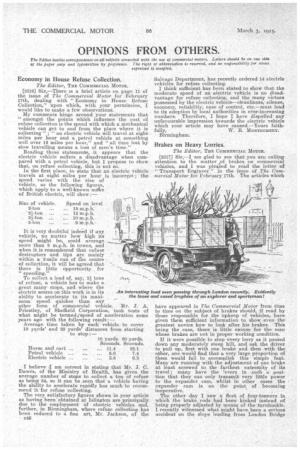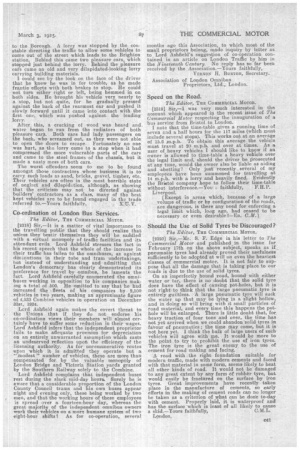[2317] Sir,—I . am glad to gee that you are calling
Page 24

Page 25

If you've noticed an error in this article please click here to report it so we can fix it.
attention to the matter of brakes on commercial vehicles, and I was pleased to read the letter of " Transport Engineer" in the issue of The Commercial Motor for February 17th. The articles which have appeared in The Commercial Motor from time to time on the subject of brakes should, if read by those responsible for the upkeep of vehicles, have given them sufficient information to show even the greatest novice how to look after his brakes. This being the case, there is little excuse for the man whose brakes are not in proper working condition.
If it were possible to stop every lorry as it passed down any moderately steep hill, and ask the driver to pull up, first with one brake and then with the other, one would find that a very large proportion of them would fail to accomplish this simple feat. Many are running with the adjustment of one brake at least screwed to the farthest extremity of its travel ; many have the levers in such a position that they can only transmit very little power to the expander cam, whilst in other cases the expander cam is on the point of becoming inoperative. • The other day I saw a fleet of four-tonners in which the brake rods had been kinked instead of being properly adjusted by means of the turnbuckle. I recently witnessed what might have been a serious accident on the slope leading from London Bridge to the Borough. A lorry was stopped by the constable directing the traffic to allow some vehicles to come out of the street which leads to the Brighton station. Behind this came two pleasure cars, which stopped just behind the lorry. Behind the pleasure cars came an old and very dilapidated-looking lorry carrying building materials.
I could see by the look on the face of the driver that he knew he was in for trouble, as he made frantic efforts with both brakes to stop. He could not turn either right or. left, being hemmed in on both sides. He brought his vehicle very nearly to a stop, but not quite, for he gradually pressed against the back of the rearmost car and pushed it slowly forward until it came into contact with the first one, which was pushed against the leading lorry.
After this, a cracking of wood was heard and water began to run from the radiators of both pleasure calla Both cars had lady passengers on the back, who screamed out, as they were not able to open the doors to escape. Fortunately no one was hurt, as the lorry came to a stop when it had compressed the more vulnerable parts of the cars and came to the steel frames of the chassis, but it made a nasty mess of both cars.
The worst offenders seem to me to be found amongst those contractors whose business it is to carry such loads as sand, bricks, gravel, timber, etc. Their vehicles are often in the most horrible state of neglect and dilapidation although, as_ showing that the criticism may not be directed against builders' contractors as a class, many of the best kept vehicles are to be found engaged in the trade referred to.—Yours faithfully, Co-ordination of London .Bus Services.
The Editor, TI3E COMMERCIAL MOTOR.
[2318] Sir,—It is a matter of vital importance to . the travelling public that they should realize that unless they bestir themselves they will be saddled with a virtual monopoly of traffic facilities and its attendant evils. Lord Ashfield stresses the fact in his recent speech that the whole of the increase in their traffic has fallen to the omnibuses, as against ditsinutions in their tube and tram undertakings, but instead of understanding and admitting that London's democracy has clearly demonstrated its preference for travel by omnibus, he laments the fact. Lord Ashfield carefully enumerated the omnibuses working in opposition to his companies making a total of BOO. He omitted to say that he had increased the fleets of his companies by 2,500 vehicles in two years, making an approximate figure of 4,533 Combine vehicles in operation on December 31st, 1924,
Lord Ashfield again makes the covert threat to the 'Onions that if they do not endorse his co-ordination views their members will almost certainly have to suffer some reduction in their wages. Lord Ashfield infers that the independent proprietor fails to make adequate provision for depreciation on an entirely unwarranted assumption which casts an undeserved reflection upon the efficiency of the licensing authority. As for unremunerative routes upon which it is admitted they operate hut a modest" number of vehicles, these are more than compensated for by the valuable monopoly of London Bridge and Victoria Station yards granted by the Southern Railway solely to the Combine.
Lord Ashfield complains that independent buses rest during the slack mid-day hours. Surely he is aware that a considerable proportion of the London County Council trams and his own buses appear night and evening only, these being worked by two men, and that the working hours of these employees is spread over a fourteen-hour day, whereas the great. majority of the independent omnibus owners work their vehicles on a more humane system of two eight-hour shifts? As for co-operation, several months ago this Association, to which most of the small proprietors belong, made inquiry by letter as to Lord Ashfield's suggestion of co-operation contained in an article on London Traffic by him in the Nineteenth Centurp. No reply has so far been received by the Association.—Yours faithfully, VERNON H. BURTON, Secretary.
Association of London Omnibus Proprietors, Ltd., London.
Speed on the Road.
The Editor, THE COMMERCIAL MOTOR.
[2319] Sir,--1 was very much interested in the account which appeared in the recent issue of The Commercial Motor respecting the inauguration of a bus service from Bristol to London. I note that the time-table gives a running time of seven and a half hours for the 117 miles (which must include several stops). This works out at an average of 15.6 .m.p.h. To obtain this average the vehicle must travel at 20 m.p.h. and over at times. As a user of heavy vehicles I should like to know if an owner is allowed to time-table a heavy vehicle over the legal limit and, should the driver be Prosecuted at any time, would the owner also be liable as aiding and abetting? Only just recently several of my employees have been summoned for travelling at 14 m.p.h. with a lorry and heavily fined. Evidently the Bristol company hope to follow their time-table
without interference.—Yow z faithfully, F.H.P. Liverpool.
[Except in areas which, because of a large volume of traffic or by configuration of the roads, are dangerous, is there any need for enforcing a legal limit which, loag ago, had ceased to be necessary or even desirable ?—En. C.M.] Should the Use of Solid Tyres be Discouraged?
The Editor, THE COMMERCIAL MOTOR.
[2320] Sir,—Mr. S. F. Edge in his letter to The Commercial Motor and published in the issue for February 17th on the above subject, speaks as if pneumatic tyres had already proved their usefulness sufficiently to be adopted at will on even the heaviest classes of commercial motor. It is not fair to suppose that all the damage that is taking place to our roads is due to the use of solid tyres.
On an imperfectly bound road, bound with either water or tar, there is no doubt that the solid tyre does have the effect of causing pot-holes, but it is not right to think that the large pneumatic tyre is entirely guiltless. A large pneumatic tyre will suck the water up that may be lying in a slight hollow, and in doing so will bring with it small particles of road material, and every time this happens the pothole will be enlarged. There is little doubt that, for heavy traction of four tons and over, the time has not yet arrived when we could abandon solid tyres in favour of pneumatics ; the time may come, but it is not here yet. I think the bulk of large users of such vehicles will agree with me. It would be more to the point to try to prohibit the use of iron tyres. The iron tyre is the great enemy to the use of cement for road making and facing.
A road with the ript foundation suitable for modern traffic, made with modern cements and faced with that material in some form, seems likely to beat all other kinds of road. It would not be damaged to any great extent by any form of rubber tyre, but would easily be fractured on the surface by iron tyres. Great improvements have recently taken place in the manufacture of cements, so early efforts in the making of cement roads can no longer be taken as a criterion of what can be done to-day with cement. Properly laid, it is waterproof and has the surface which is least of all likely to cause a skid.—Yours faithfully,
London.




























